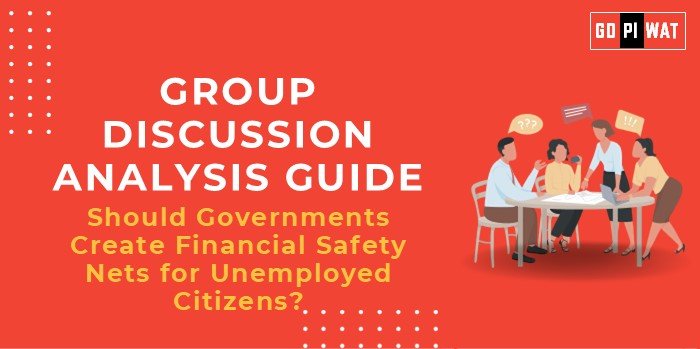📋 Group Discussion (GD) Analysis Guide: Should Governments Create Financial Safety Nets for Unemployed Citizens?
🌍 Introduction to the Topic
- 💡 Opening Context: The concept of financial safety nets for unemployed citizens has gained global relevance due to economic uncertainties, automation, and the COVID-19 pandemic’s lasting impacts. Governments worldwide are exploring these frameworks to reduce social inequities and stabilize economies.
- 📜 Background: Originating from social welfare systems, financial safety nets have evolved into sophisticated structures, encompassing unemployment insurance, direct cash transfers, and universal basic income (UBI) initiatives. Notable implementations in countries like Germany (Hartz reforms) and Finland’s UBI experiments provide valuable insights.
📊 Quick Facts and Key Statistics
- 🌍 Global Unemployment Rate: 5.7% (ILO, 2023) – Highlights economic disparity worldwide.
- 🇮🇳 India’s Unemployment Rate: 7.6% (CMIE, 2024) – Indicates the need for targeted intervention.
- 🌐 Universal Basic Income Pilots: Implemented in over 20 countries, showcasing varying success.
- 📉 Social Welfare Spending in OECD Nations: Average 20% of GDP – Highlights prioritization by developed economies.
👥 Stakeholders and Their Roles
- 🏛️ Governments: Policy formulation and funding for unemployment safety nets.
- 🏢 Private Sector: Job creation, skill development programs, and economic participation.
- 🤝 NGOs: Advocacy and implementation of community-based welfare programs.
- 👥 Citizens: Active participation in policy feedback and upskilling opportunities.
🏆 Achievements and ⚠️ Challenges
Achievements:
- ✅ Reduced Poverty: Unemployment benefits in the EU have significantly lowered poverty rates.
- 📈 Economic Stability: Stimulus checks during COVID-19 mitigated recession impacts in the U.S.
- 📚 Job Transition Assistance: Scandinavian countries provide income and training, enabling swift reemployment.
Challenges:
- ⚠️ Financial Viability: High fiscal burden for developing economies.
- 📉 Targeting Issues: Risk of exclusion or fraud in identifying beneficiaries.
- 💬 Dependency Concerns: Safety nets might discourage active job-seeking behavior.
Global Comparisons:
- 🇩🇪 Germany: Hartz reforms reduced long-term unemployment.
- 🇫🇮 Finland: Mixed results from UBI experiments regarding motivation and employment.
Case Studies:
- 🇮🇳 India’s MGNREGA: Offers a rural employment safety net but faces implementation hurdles.
📋 Structured Arguments for Discussion
- 📈 Supporting Stance: “Financial safety nets reduce poverty, provide economic stability, and serve as crucial buffers during downturns.”
- 📉 Opposing Stance: “Such policies impose unsustainable fiscal burdens and may foster dependency among citizens.”
- ⚖️ Balanced Perspective: “Financial safety nets are beneficial but must be carefully designed with phased implementation and fiscal prudence.”
💡 Effective Discussion Approaches
- 📊 Opening Approaches:
- 📖 “Post-pandemic, unemployment has emerged as a global challenge necessitating innovative solutions such as financial safety nets.”
- 📈 “Comparing global unemployment schemes, India’s need for a structured safety net becomes evident.”
- 🔍 Counter-Argument Handling:
- 💬 “While fiscal challenges exist, leveraging public-private partnerships can distribute costs effectively.”
- 📚 “Dependency concerns are mitigated by linking benefits to skill enhancement programs.”
🔍 Strategic Analysis of Strengths and Weaknesses
- ✨ Strengths: Enhances economic stability, reduces poverty.
- ⚠️ Weaknesses: High cost, implementation challenges.
- 🚀 Opportunities: Incorporating digital tools for effective targeting and distribution.
- ⛔ Threats: Risk of political misuse and over-dependence.
📘 Connecting with B-School Applications
- 📚 Real-World Applications: Economic policy analysis, public finance management projects.
- 💬 Sample Interview Questions:
- 🔎 “How can India fund a universal financial safety net?”
- 🔎 “What role can AI play in efficient benefit distribution?”
- ✨ Insights for B-School Students:
- 🌐 Understanding the intersection of social welfare and economic growth aids strategic decision-making.


